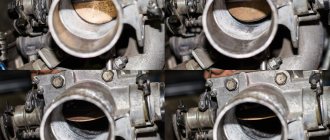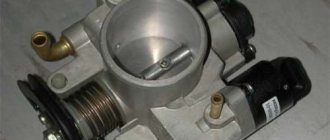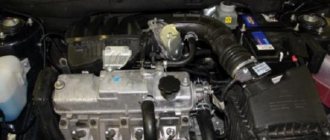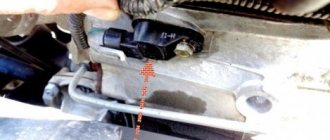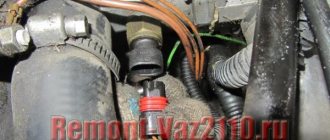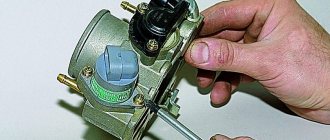The Lada Granta speed sensor is located on the gearbox housing. This regulator is directly related to the transmission of data about how fast the vehicle is moving, how the car is idling, and what kind of gas mileage it is driving at.
To find this controller on a Priora or Grant, you need to open the hood and remove the air supply hose that goes from the air filter element to the throttle. Having done this, at the bottom of the gearbox housing you can see the controller with a wire connected to it. To replace the device, you simply need to disconnect the wiring and remove it from the installation location, and then replace it with a new one.
Removing DTOZH from a car
A coolant temperature sensor is necessary to measure the temperature of antifreeze in the cooling system. In accordance with the data from the temperature regulator on the Grant, the control unit adjusts the crankshaft speed, adjusts the composition of the combustible mixture, as well as the ignition timing.
As practice shows, such a device rarely fails, but in some cases it can give incorrect readings. Located in the engine compartment, in particular, in the thermostat cover, the controller has its own “diseases”. The wiring at the base of the connector may fray, resulting in the need to replace the DTOZH.
The mass air flow controller is located behind the air filter element of the power unit, it is also often called a flow meter. The main purpose of the device is to monitor the volume of air flow that enters the vehicle engine. In accordance with the data received, the on-board computer determines the required volume of gasoline, which is necessary to maintain a normal air-fuel ratio.
The idle speed sensor is one of the regulators designed to monitor and control the operation of the power unit. If the device breaks down, the motor immediately begins to work incorrectly - it will trip and the power will decrease. In turn, the needle on the tachometer will jump sharply from one value to another. The element itself is located on the throttle, in particular on its lower part. To get to it, you need to free the throttle valve from the pipes, there are four in total.
To replace and install a new IAC, you will need to disconnect the wiring from the regulator itself, as well as the throttle position controller. More detailed instructions for replacing the controller yourself are given in the video below (the author of the video is the channel In Sandro's Garage).
Sveta
As for the light sensor, it is installed in the same housing with the rain regulator. Its purpose is to activate and deactivate lighting based on the current state. For example, if it gets dark outside or you enter a garage or poorly lit tunnel, the device should automatically turn on the headlights along with the side lights. The controller itself is not repairable, so if it fails, the only option is to replace it.
Clutches and brakes
The clutch sensor allows you to determine the position of the pedal. When the pedal is not depressed, the regulator turns off the load adjustment on the power unit. The device is located in the pedal assembly, in the same place where the brake sensor is located.
Location of the idle speed sensor on the Lada Granta
The following two tabs change content below.
Lada expert An expert on Lada cars with many years of experience. I own a Lada Granta car, I collect cramps based on the Priora. Sometimes I stay overnight in the garage. My wife is more jealous of cars than of women.
The Lada Granta with an electronic pedal does not have an idle speed sensor! That's why they sent you from the store to remove yours. There is only one idle speed sensor, you can’t go wrong if you have one, of course.
This is what the electronic pedal looks like
Finding out which pedal you have is easy. If you have a throttle cable under the hood, then you have a regular pedal. So, if you do not have an electronic pedal, then the sensor is located on the throttle valve assembly, or rather in its lower part.
Throttle assembly without idle speed control (electronic gas pedal)
To remove it, you must:
- remove power from the battery;
- remove the power supply from the idle speed sensor;
- unscrew the two fastening bolts;
- remove the idle speed sensor.
In the picture the idle speed sensor is indicated in red, the throttle assembly has also been removed
We diagnose the breakdown
There can be many reasons for a situation where the engine of a Lada Granta starts and immediately stalls. And this is not necessarily the idle speed sensor.
In my experience, I can say that you can still drive an 8-valve Granta with a breakdown of this sensor, since the engine is a “tractor” one. But 16-valve engines will stall, since these are high-revving engines. Therefore, if your 8-valve valve stalls, the reason may not be a breakdown of the idle speed sensor. But if it’s a 16-valve engine, then the symptoms you described are correct. By the way, Lada Prioras behave the same way, they have the same 16-valve valve.
Car : Lada Granta. Asks : Roman Chebotarev. Question : Where is the idle sensor located on a Lada Granta car?
I started the car in the morning, but the engine was running hot. The tachometer needle jumps from 1000 to 1500, and then goes to 500 and the engine stalls. It shakes a lot. I try to apply the gas, to no avail. I went to a car store and they recommended that I pay attention to the idle speed sensor. They said that there are several types, and that I should unscrew the old one and bring it to them. But I don't know where it is. Please tell me where to look for this sensor, under the hood?
Clutch and brake sensors Lada Granta
Thanks to the signals sent by these sensors, the controller receives information about whether the corresponding pedals (clutch and brake) are pressed or not pressed. Both elements are located in the area of the pedal assembly.
The clutch sensor is a stabilizer, which from a design point of view is a limit switch. Its failure will lead to surges in speed and unstable operation of the engine. The car owner will be informed about the breakdown by the illuminated Check Engine; in addition, problems will appear with sudden jumps in speed during gear shifts.
The above is evidence of the following malfunctions:
- the height of the pedal is incorrectly positioned relative to the floor;
- clutch sensor is faulty;
- there are disturbances in the circuit.
They also began installing brake pedal sensors on Grants. However, many owners of this car, after only using it for a short time, notice error P0504, indicating a breakdown of this sensor. In most of these cases, the above error occurs due to incorrect adjustment of the element. For this reason, car owners report symptoms such as:
- unstable engine operation;
- instability of speed.
Functionally, the brake pedal sensor is responsible for the position of the pedal itself and turning off the brake lights. In addition to its misalignment, problems with this part can be caused by a breakdown of the spring located inside the sensor.
The presence of a malfunction will be confirmed to the owner by the illuminated Check Engine and the already mentioned error P0504. This error is a consequence of a breakdown of either the sensor itself or its wiring. In addition, the cause of the error is often the misalignment already mentioned above. The new element will cost the car enthusiast approximately 180 rubles.
Conclusion
Replacing the idle speed control is not a panacea in the fight against floating speed or a throbbing engine. Most automotive electricians have a tester in their arsenal to check the operation of the regulator. To do this, remove yours and give it for inspection. The regulator glitch may be intermittent, but the tester will show the correct picture.
The idle speed sensor in the injection system of the Lada Kalina model is a special electronic device. Such a component can be found in any other car that runs on gasoline and has distributed injection. The design of the sensor is represented by an electric motor, paired with a conical needle by the manufacturer. Note that the device is controlled by an ECU.
The idle speed sensor rarely experiences malfunctions, but if such a fact occurs, it causes a malfunction in the idle speed of the engine. They begin to “float”, and the engine, in turn, ceases to function normally. As a result, achieving a timely return to operating temperature after a cold start becomes problematic.
Checking pxx with a multimeter
Testing with a tester is considered more accurate; a multimeter is used to diagnose all electronic components of a car. Learn how to check the functionality of the regulator and power circuit step by step.
The operating voltage supplied to the controller contacts must correspond to 20 V. Multimeter probes are applied to the outputs of the block; if there is no signal, the quality of the contacts on the part, the ECU unit, is checked.
The serviceability of the DX is calculated using the resistance parameter. The tester is switched to ohmmeter mode, the resistance of the sensor winding is checked, which should be at the level of 53 Ohms, the permissible deviation is ±1%.
Restoration of the controller is rarely carried out, the average cost of the sensor is 500 rubles, the service life is from 3 years. After installing a new part, you need to calibrate the regulator. To do this, turn on the ignition, set the engine to idle for 5–10 minutes, and stop. When re-ignited, the IAC will calibrate on its own.
The idle speed sensor for Priora is not a frequent consumable. It is quite easy to reinstall the controller yourself. Difficulty may arise if the power to the supply block is interrupted. Car electrical circuit repairs are carried out in a garage if you have the necessary skills and knowledge, otherwise it is recommended to contact a workshop.
Functional features
The main purpose of the sensor discussed here in Lada Kalina is to measure the main parameters in the intake system and adjust the speed. This is done by sending pulses to the engine control module, which, based on the data received, adjusts the volume of injected fuel.
Due to the fact that the specified idle speed regulator acts as an actuator, determining its failure is a very difficult task. This is due to the lack of a useful self-diagnosis function in the Lada Kalina.
The device is designed to control the volumes of air that are directed through the intake tract into the combustion chambers of the engine. Here, the air mass (also measured by the mass air flow sensor) enters through a special channel, bypassing the throttle valve, which is closed in idle speed mode.
This idle speed regulator is involved in warming up the 8-valve engine, ensuring that the unit reaches its operating temperature in a timely manner.
When the ignition is turned on, a rod “crawls out” from the regulator and reaches a specially designed hole. This is called the initial position of the sensor.
Next, we outline the primary functions of this device:
- adjusting the optimal air mass;
- participation in warming up the engine 8 valves;
- determination and adjustment of the number of revolutions.
Lada Granta (2011). Troubleshooting throttle position sensor
What does the throttle position sensor do?
A part such as a throttle position sensor (TPS) is designed to transmit information to the electronic engine control unit about the exact state of the bypass valve at a given moment in time. Essentially, it is a combination of a fixed and variable resistor, and its maximum total resistance is approximately 8 ohms. The TPS has three contacts in its design, two of them are supplied with voltage (usually its value is about 5 V), and the third is a signal and is connected to the corresponding controller
Symptoms of a malfunctioning throttle position sensor
The throttle position sensor in the fuel system plays a “smoothing” role, and therefore, if it is working properly, then the car drives without jerking, smoothly, and demonstrates “responsiveness” when you press the gas pedal. If the TPS is faulty, then this can be determined by the following signs:
-The engine starts to start poorly; -Fuel consumption increases significantly; -The car drives jerkily; -The number of engine revolutions at idle increases significantly; -When the car accelerates, it happens with some delay; - “Popping” sounds are heard from the intake manifold; -The engine stalls at idle; -The Check Engine light either stays on constantly or lights up intermittently. If at least one of the above symptoms appears, then it is likely that the TPS is faulty. As practice shows, in most cases, the breakdown of this part is associated with its natural wear and tear. The fact is that the variable resistor present in the design of the throttle position sensor has a sprayed base layer, which the metal contact moving over it wears out over time. Accordingly, the TPS begins to produce incorrect data.
Signs of a bad throttle valve
The throttle assembly regulates the air supply to the intake manifold, which subsequently creates an air-fuel mixture with parameters that are optimal for the engines. Accordingly, if the throttle valve is faulty, the technology for creating this mixture changes, which negatively affects the behavior of the car. Specifically, signs of a bad throttle position include:
- problematic engine starting, especially “cold”, that is, on an unheated engine, as well as its unstable operation; - the engine speed value constantly fluctuates, and in a variety of modes - at idle, under load, in the average range of values; -loss of dynamic characteristics of the car, poor acceleration, loss of power when driving uphill and/or with a load; - “dips” when pressing the accelerator pedal, periodic losses of power; -increased fuel consumption; - a “garland” on the dashboard, that is, the Check Engine indicator light comes on and then goes out, and this repeats periodically; - the engine suddenly stalls, after restarting it works normally, but the situation soon repeats; - frequent occurrence of engine detonation; -a specific gasoline smell appears in the exhaust system, associated with incomplete combustion of fuel; - in some cases, self-ignition of the air-fuel mixture occurs; - in the intake manifold and/or in the muffler, soft popping noises are sometimes heard.
Causes of throttle valve malfunction
There are a number of typical reasons that lead to malfunctions of the throttle assembly and the problems described above. Let us list in order what malfunctions of the throttle valve can occur.
Idle speed control
The idle air control valve (or IAC for short) is designed to supply air to the intake manifold of the engine when it is idling, that is, when the throttle valve is closed. If the regulator fails partially or completely, the engine will experience unstable operation at idle until it stops completely. Since it and the throttle assembly work in tandem.
Throttle sensor malfunctions
Another common cause of throttle failure is problems with the throttle position sensor (TPS). The function of the sensor is to fix the position of the throttle valve in its seat and transmit the corresponding information to the ECU. The control unit, in turn, selects a certain operating mode, the amount of supplied air, fuel and adjusts the ignition timing. If the throttle position sensor malfunctions, this unit transmits incorrect information to the computer or does not transmit it at all. Accordingly, the electronic unit, based on incorrect information, selects incorrect engine operating modes or switches it to operation in emergency mode. Typically, when a sensor fails, the Check Engine light on the dashboard lights up.
Throttle Actuator
There are two types of throttle valve actuator - mechanical (using a cable) and electronic (based on information from a sensor). A mechanical drive was installed on cars of older models, and is now becoming less common. Its operation is based on the use of a steel cable connecting the accelerator pedal and the lever on the throttle rotation axis. The cable can stretch or break, although this is quite rare.
Electronic throttle control is widely used in modern cars. Commands for the throttle position are received by the electronic control unit based on information received from the damper actuator sensor and the throttle sensor. If one or another sensor fails, the control unit is forced into emergency mode. In this case, the damper drive is turned off, an error is generated in the ECU memory, and the Check Engine warning lamp lights up on the dashboard. The problems described above arise in the behavior of the machine:
- the car reacts poorly to pressing the accelerator pedal (or does not react at all); - engine speed does not rise above 1500 rpm; - the dynamic characteristics of the machine are reduced; -unstable idle speed, up to the complete stop of the engine. In rare cases, the damper drive motor fails. In this case, the damper is located in one position, which fixes the control unit, putting the machine in emergency mode.
System depressurization
Often the cause of unstable operation of a car engine is depressurization in the intake tract. In particular, air can be sucked in in the following places: - the place where the damper is pressed against the body, as well as its axis; - cold start jet; - connecting corrugated tube behind the throttle position sensor; -joint (inlet) of the crankcase gas cleaner pipe and corrugation; - injector seals; - conclusions for gasoline fumes; - vacuum brake booster pipe; -throttle body seals.
Air leaks lead to incorrect formation of the air-fuel mixture and errors in the operation of the intake tract. In addition, the air leaking in this way is not cleaned in the air filter, so it may contain a lot of dust or other harmful small elements.
Damper contaminated
The throttle body in a car engine has a direct connection with the crankcase ventilation system. For this reason, tar and oil deposits and other debris accumulate on its body and axle over time. Typical signs of throttle valve contamination occur. This is reflected in the fact that the valve does not move smoothly; it often sticks and jams. As a result, the engine is unstable and corresponding errors are generated in the electronic control unit.
To get rid of such troubles, you need to regularly check the condition of the throttle valve, and if necessary, clean it with special means, for example, carburetor cleaners or their equivalents.
The damper adaptation has failed
In rare cases, throttle adaptation may be reset. This may also lead to the above problems. The reasons for the failed adaptation may be: - disconnection and further connection of the battery in the car; - dismantling (disconnection) and subsequent installation (connection) of the electronic control unit; - the throttle valve has been removed, for example, for cleaning; -the accelerator pedal has been removed and reinstalled. Also, the cause of a failed adaptation may be moisture getting into the chip, a break or damage to the signal and/or power wire. You need to understand that there is an electronic potentiometer inside the throttle valve. Inside it there are tracks coated with graphite. Over time, during the operation of the unit, they wear out and can wear out to such an extent that they will not transmit correct information about the position of the damper.
contents .. 231 232 233 234 ..
We determine the malfunction ourselves
The regulator is designed to maintain idle speed in a given range and ensure correct and timely warming up of the engine.
Although malfunctions in the functioning of the engine in this mode rarely occur on the Lada Kalina, practice has made it possible to establish a certain set of signs indicating a malfunction of the regulator.
- difficulties starting the unit;
- when the gearbox is in the neutral position, “floating” engine speeds are observed;
- when switching transmission stages on the move, the engine stops without authorization;
- Once the unit begins to warm up at low outside temperatures, the speed is not able to overcome the 1500 per minute mark, which “delays” the time it takes to reach operating temperature.
Observant owners of Lada Kalina testify to a decrease in speed after turning on the air conditioning compressor. This often leads to the engine stopping, and the lubricant pressure symbol in the unit lights up on the instrument panel.
The most common breakdown is instability of speed. For mileages exceeding the 50,000 mile mark, and if such symptoms appear, we first recommend cleaning the cavity of the throttle assembly. Only after this can the regulator be replaced. This device cannot be repaired, so this action becomes a non-alternative measure.
Replacing the sensor is not characterized by any difficulties and allows you to do it as quickly as possible, the main thing is to know where it is.
Coolant temperature sensor Lada Granta
The main functions of this part include measuring and monitoring the temperature of the coolant in the engine cooling system. Based on the data provided by the DTOZH, the ECU corrects the frequency at which the crankshaft rotates, and the system also corrects the ignition timing and the composition of the air-fuel mixture. Thus, this element must ensure rapid heating of the motor when it starts, and it is also responsible for maintaining the temperature required for each operating mode.
In general, the DTOZH on Grant is not prone to breakdowns, but sometimes it can provide incorrect information. Install them on the thermostat covers.
DTOZH are thermistors that have negative temperature coefficients; their resistance level becomes lower as the temperature increases. Thanks to the controller, the DTOZH receives a stabilized voltage; after it drops, the element calculates the coolant temperature. The ECU will alert the car owner if any of its circuits are broken, then the controller will activate the cooling system fan. Temperature readings in such cases are calculated using a workaround algorithm.
The sensor influences the starting of the motor and its subsequent operation. The car owner will learn about its possible breakdown by noting the presence of the following symptoms:
- problems when starting the engine in cold weather;
- exceeding fuel consumption standards;
- poor exhaust from a still unheated engine;
- periodic malfunctions in the functioning of the cooling system, in particular during fan operation.
Replacing the idle speed sensor
The sensor replacement begins, we dismantle the device.
- We remove the engine screen from the LADA Kalina and disconnect the cable connectors from the corresponding blocks on the throttle unit and the idle speed controller.
- To disconnect the heating pipes, you will need to partially drain the antifreeze. We carry out the indicated manipulations.
- To dismantle the device itself, we need a regular screwdriver with a cross-shaped profile.
- We remove the pipe leading from the crankcase ventilation system. We do this by loosening the clamps and moving them. We are temporarily putting this hose aside.
- We repeat such manipulations with the refrigerant supply pipes (if they have not been previously removed) and the purging of the absorber circuit.
- Using the key set to “13” (the head is more convenient), we remove the throttle block. It is attached to the inlet receiver with nuts.
- Let's look at the gasket. If damage is found, we must replace it, otherwise the intake system will receive unwanted air leaks.
- Installation of the regulator in the LADA Kalina car is also simple and is carried out with an eye to the reverse sequence of manipulations during disassembly.
- It is important to pre-measure the needle here. The optimal position will confirm the exit from the regulator body to a length of at least 23 mm. For measuring action we use a caliper. If the required value is not achieved, then you will need to “recess” the valve itself into the regulator body. Here we connect the positive contact of the device to the corresponding terminal of the battery (you will need a temporary cable).
We apply the bare edge of the element to the negative contact. The needle moves slowly, and therefore quite a lot of such touches will be required.
Malfunctions and replacement of the VAZ 2110 throttle position sensor
The VAZ 2110 throttle sensor (TPS) is an automobile potentiometer that transmits data to the regulator about how the throttle is positioned. The latter can change its location depending on the intensity of pressure on the gas pedal. There is a voltage regulator at the base of this device.
Its readings are recorded by the controller and, taking into account the available information, it supplies gasoline in portions. If it breaks down, the controller will receive distorted information. This can lead to suspension of its operation and excessive fuel consumption.
As a result of the signal pulse from the TPS, the controlling sensor evaluates the current throttle position, and the intensity of the signal change analyzes the degree of pressure on the accelerator pedal. This becomes a decisive circumstance for activating the necessary modes, as well as directing the air flow past the throttle through the idle shut-off and control mechanism. The TPS in a VAZ car is located in the engine compartment on the throttle fitting. It connects to the damper shaft.
Elimination of floating speeds
- heads with a ratchet, and their size should be 6 and 8;
- neutral sealant, when purchasing, pay special attention to ensure that it is odorless;
- Silicone Grease;
You need to disconnect and remove the throttle cable stopper from the lever. This work must be done specifically on the throttle assembly. Next you will need to remove the resonator and air pipe. Using TORX T-25 heads and bits that were previously purchased, you need to unscrew the air filter shell. To be able to carry out this work with maximum convenience, you need to remove the wire from the exhaust receiver and all associated fasteners going to the throttle assembly.
Now, having removed the obstacle from the throttle assembly, unscrew all the bolt heads using a ratchet head to do this job. Only after this will it be possible to remove the remote control and remove the rubber rings that serve as a seal at the two ends of the throttle valve. All grooves need to be cleaned as much as possible and the FUM tape should be wound around them in a circle, about 15 times, and on the small pipe - about 10 times.
Only after completing this work can you begin to fully assemble the elements into a single whole. It would also be useful to use a clamp when securing the channel hose and the tube leading to the vacuum booster. This is necessary to further prevent air leaks in the connections.
To check whether the speed on the Lada Granta is floating, look at the IAC sensor. It is located on the throttle body, therefore, in the same place as the sensor responsible for the throttle position. It is secured with two mounting screws. In order to verify its functionality, one multimeter will be enough.
If the vehicle readings are normal, it should be within approximately 80 ohms. In the same case, if the indicators turned out to be significantly higher than the IAC norm, it will be necessary to replace it.
At the moment when the ignition is turned on directly, the rod located on the regulator fully extends and rests against a specially made calibration hole. It is located directly in the throttle pipe. After this, the sensor begins to count steps until the required time and returns the valve to its original state upon completion of operation.
The main reason for the unstable operation of the Lada Granta engine at idle is a malfunction of the regulator , throttle position sensor.
